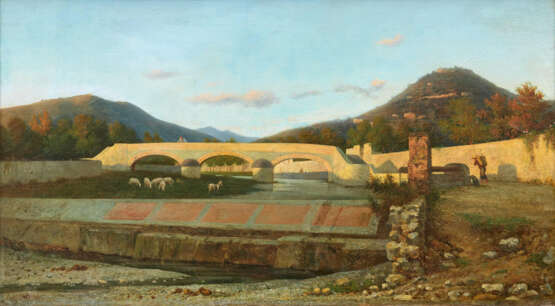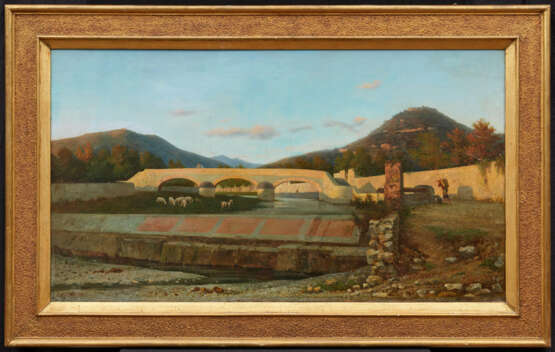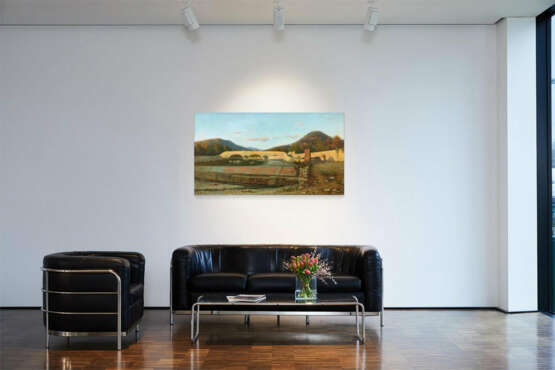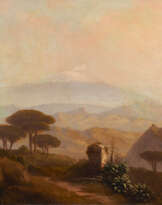ID 1319913
Lot 1346 | Francesco Lojacono. The Oreto Valley near Palermo
Valeur estimée
€ 20 000 – 40 000
Palermo 1838 - 1915
Title:
The Oreto Valley near Palermo.
Technique:
Oil on canvas.
Mounting:
Relined.
Measurement:
85 x 150cm.
Notation:
Signed lower left: "F. LoJacono".
Frame:
Framed.
Provenance:
Private ownership, Italy.
Francesco Lojacono was one of Italy's leading painters in the 19th century and is considered the most important landscape painter in Sicily of his time. He gave new impetus to painting in his homeland and brought about development from romantic idealism to contemporary realism.
The young Francesco Lojacono was initially trained by his father, Luigi Lojacono, and his godfather, Salvatore Lo Forte, who were both painters. His first successful exhibition participation in 1856 was honoured with an award and a scholarship to Naples, where Lojacono studied with the Palizzi brothers. Through them, the young artist came into contact with the influences of the Barbizon School and European Realism. During this time in Naples, however, he was also impressed by landscape painting as practised there by the representatives of the Posillipo School from the 1820s onwards. They also painted in nature but paid particular attention to light effects.
Francesco Lojacono returned to Sicily in 1859. At the beginning of the 1860s, he fought in the wars of independence but remained active as an artist. He also kept in touch with Naples and joined the circle of the non-academic so-called 'School of Resina' around the artist Giuseppe de Nittis. Lojacono participated in numerous Italian exhibitions, and the public and critics very favourably received his work.
In the 1870s, he travelled to the capitals of Europe, exhibited at the Paris Salon and had contact with the high nobility. The sale of a painting to the new King Vittorio Emanuele II gave Francesco Lojacono's career an enormous boost in 1877. In the same year, the 36-year-old artist became a jury member for the World Exhibition in Paris. A year later, he became an honorary professor at the Academy in Naples. In 1895, he was appointed professor at the Accademia di Belle Arti in Palermo, a post he held until 1914.
The present painting is radical in its composition. The eye has to negotiate various obstacles, a barrage, a bridge and walls running to the side and behind it before the view meets the wooded, hilly landscape beneath the blue sky. It is not a picturesque view, even if sheep and a goat are grazing on the banks of the little river, being watched by a figure on the bridge. Another person, probably a farm labourer, is bent over on the right-hand edge of the picture, carrying a pannier on his back.
The atmosphere is that of a late, still warm autumn day with the sun already low in the sky. The shading of the foreground, a trick that Francesco Lojacono may have first seen in the Posillipo painters and which he often used in his paintings, also characterises this picture. The painter's position is in this shadowy area, which is caused by the landscape in an undefined way. The warm sunlight barely hits the bridge and the wall on the right, competing with the sky for the most extraordinary radiance in light ochre yellow. The cool, bluish foreground continues in the depths of the painting in the course of the river. The charming detail of the red squares on the barrage is repeated in the red brick pillar and occasionally in the autumn leaves. Francesco Lojacono demonstrates his great mastery as a colourist in this painting.
| Artiste: | Francesco Lojacono (1838 - 1915) |
|---|---|
| Technique appliquée: | Huile |
| Catégorie maison de vente aux enchères: | Peintures de maîtres récents |
| Artiste: | Francesco Lojacono (1838 - 1915) |
|---|---|
| Technique appliquée: | Huile |
| Catégorie maison de vente aux enchères: | Peintures de maîtres récents |
| Adresse de l'enchère |
VAN HAM Kunstauktionen GmbH Hitzelerstr. 2 50968 Köln Allemagne | ||||||||||||||
|---|---|---|---|---|---|---|---|---|---|---|---|---|---|---|---|
| Aperçu | |||||||||||||||
| Téléphone | +49 221 92586215 | ||||||||||||||
| Fax | +49 221 92 58 62 4 | ||||||||||||||
| Commission | 32% | ||||||||||||||
| Conditions d'utilisation | Conditions d'utilisation | ||||||||||||||
| Heures d'ouverture | Heures d'ouverture
|







